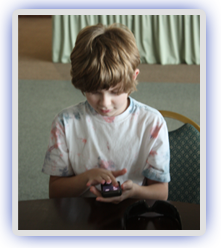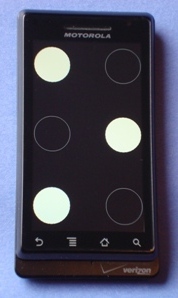
About V-Braille
Modern smart phones like the iPhone, Windows phones, and Google Android phones have the ability to output speech and vibrations, which make them suitable as multi-modal devices for blind children to learn Braille and other useful information. V-Braille is an infrastructure for smart phones that employs vibration as the means for reading Braille. Additionally, it uses both vibration and text-to-speech for entering (or "writing") Braille. Using this infrastructure, the V-Braille research project* is currently designing Braille-learning games that blind (and sighted) children can play on smart phones.

The Braille letter 'O'
V-Braille evenly divides the phone's touchscreen into six regions, each of which contains a dot, in order to represent the layout of the standard Braille cell. Dots one, two and three form a column down the left side of the screen and dots four, five and six form a column down the right side of the screen. In V-Braille, "raised" dots are displayed as solid white circles that vibrate when touched. Dots that are not raised are displayed simply as outlines and do not vibrate when touched. In this way, one Braille letter at a time is presented on the screen. Using the device's text-to-speech capability, dot numbers are spoken when they are touched in order to help users navigate the touchscreen regions.
*Research supported by the US Department of Education, Grant Number H327A100014.




